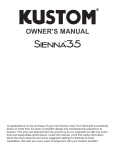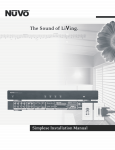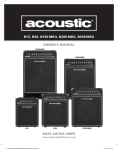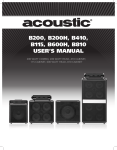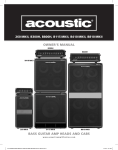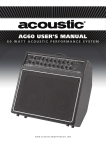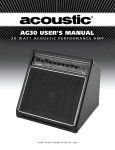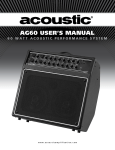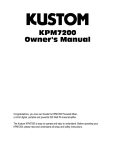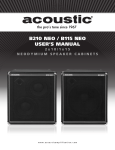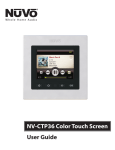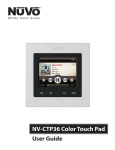Download View User`s Manual [US] - Acoustic Amplification
Transcript
USER’S MANUAL 20 WATT ACOUSTIC INSTRUMENT AMP www.AcousticAmplification.com U FCC Statements 1. Caution: Changes or modifications to this unit not expressly approved by the party responsible for compliance could void the user’s authority to operate the equipment. 2. Note: This equipment has been tested and found to comply with the limits for a Class B digital device, pursuant to Part 15 of the FCC Rules. These limits are designed to provide reasonable protection against harmful interference in a residential installation. This equipment generates, uses, and can radiate radio frequency energy and, if not installed and used in accordance with the instructions, may cause harmful interference to radio communications. However, there is no guarantee that interference will not occur in a particular installation. If this equipment does cause harmful interference to radio or television reception, which can be determined by turning the equipment off and on, the user is encouraged to try to correct the interference by one or more of the following measures: • Reorient or relocate the receiving antenna. • Increase the separation between the equipment and receiver. • Connect the equipment into an outlet on a circuit different from that to which the receiver is connected. • Consult the dealer or an experienced radio/TV technician for help. All trademarks and registered trademarks mentioned herein are recognized as the property of their respective holders. 1403-10095 www.AcousticAmplification.com U USER’S MANUAL 20 WATT ACOUSTIC INSTRUMENT AMP IMPORTANT SAFETY INSTRUCTIONS IMPORTANTES INSTRUCTIONS DE SECURITE 1. 2. 3. 4. 5. 6. 7. Read these instructions. Keep these instructions. Heed all warnings. Follow all instructions. Do not use this apparatus near water. Clean only with dry cloth. Do not block any ventilation openings. Install in accordance with the manufacturer’s instructions. 8. Do not install near any heat sources such as radiators, heat registers, stoves, or other apparatus (including amplifiers) that produce heat. 9. Do not defeat the safety purpose of the polarized or grounding-type plug. A polarized plug has two blades with one wider than the other. A grounding-type plug has two blades and a third grounding prong. The wide blade or the third prong are provided for your safety. If the provided plug does not fit into your outlet, consult an electrician for replacement of the obsolete outlet. 10.Protect the power cord from being walked on or pinched particularly at plugs, convenience receptacles, and the point where they exit from the apparatus. 11. Only use the attachments/accessories specified by the manufacturer. 12. Use only with the cart, stand, tripod, bracket, or table specified by the manufacturer, or sold with the apparatus. When a cart is used, use caution when moving the cart/ apparatus combination to avoid injury from tip-over. 13. Unplug this apparatus during lightning storms or when unused for long periods of time. 14.Refer all servicing to qualified service personnel. Servicing is required when the apparatus has been damaged in any way, such as power-supply cord or plug is damaged, liquid has been spilled or objects have fallen into the apparatus, the apparatus has been exposed to rain or moisture, does not operate normally, or has been dropped. 15. Refer all servicing to a qualified service professional. Servicing is required when the apparatus does not operate normally or has been damaged in any way, including damage to the power cord or plug, damage due to liquids spilled or objects dropped inside the unit, dropping the unit, or anything else that interrupts normal use of the unit. 16. WARNING: To reduce the risk of fire or electric shock, do not expose this apparatus to rain or moisture. 17. When the MAINS plug, or an appliance coupler is used as the disconnect device, the disconnect device shall remain readily operable. 18. Protective Ground Terminal: The apparatus shall be connected to an AC main socket with a protective earth ground connection 1. 2. 3. 4. 5. 6. 7. 13. Débranchez cet appareil pendant les orages ou lorsqu’il n’est pas utilisé pendant de longues périodes de temps. 14. Confiez toute réparation à un personnel qualifié. Une réparation est nécessaire lorsque l’appareil a été endommagé de quelque façon que ce soit, comme par exemple si le cordon d’alimentation ou la fiche sont endommagés, du liquide a été renversé ou des objets sont tombés dans l’appareil, si l’appareil a été exposé à la pluie ou à l’humidité, s’il ne fonctionne pas normalement ou s’il est tombé. 15. Pour toutes interventions techniques s’adresser à un technicien qualifié.L’intervention technique est nécessaire lorsque l’appareil aété endommagé de n’importe quelle façon, comme par exemple si le cordon secteur ou sa fiche sont détériorés,si du liquide acoulé ou si des objets sont tombés à l’intérieur de l’apparei1 ,si l’appareil a été exposé à la pluie ou à l’humidité, s’il ne fonctionne pas normalement ou s’il est tombé. 16. ATTENTION: Pour réduire le risque d’incendie ou de choc electrique ne pas exposer l’appareil à la pluie ou à l’humidité. 17. Quand La prise MAINS, au coupler, est utilisé pour la source d’alimentation êlectrique. Il est conseillê de garder cette prise facilement accessible. 18. Borne de terre de protection: L’appareil doit être connecté à un connecteur AC principale avec un raccordement à la terre de protection. Lisez ces instructions. Conservez ces instructions. Respectez tous les avertissements. Suivez toutes les instructions. N’utilisez pas cet appareil près de l’eau. Nettoyez avec un chiffon sec. Ne bloquez pas les ouvertures de ventilation. Installez-les conformément aux instructions du fabricant. 8. Ne l’installez pas près de sources de chaleur telles que des radiateurs, des ouvertures, des poêles ou d’autres appareils (incluant les amplificateurs) produisant de la chaleur. 9. Ne contournez pas le dispositif de sécurité de la fiche polarisée ou masse. Une fiche polarisée possède deux lames dont une plus large que l’autre. Une fiche de terre a deux lames et une troisième broche de masse. La lame large ou la troisième broche sont fournies pour votre sécurité. Si la fiche fournie ne rentre pas dans votre prise, consultez un électricien pour le remplacement de la prise obsolète. 10. Protégez le cordon d’alimentation pour qu’il ne soit pas piétiné ou pincé, en particulier au niveau des fiches, des prises de courant et du point de sortie de l’appareil. 11. Utilisez uniquement les fixations / accessoires spécifiés par le fabricant. 12. Utilisez uniquement avec le chariot, le stand, le trépied, le support de table spécifiés par le fabricant, ou vendus avec l’appareil. Lorsque vous utilisez un chariot, soyez prudent(e) lorsque vous déplacez le chariot / l’appareil pour éviter des blessures dues au renversement. DANGER Exposure to extremely high noise levels may cause permanent hearing loss. Individuals vary considerably to noise-induced hearing loss but most will lose some hearing if exposed to intense noise for a sufficient period of time. The U.S. Government’s Occupational Safety and Health Administration (OSHA) has specified the following permissible noise level exposures: DURATION PER DAY (HOURS) 864321 SOUND LEVEL (dB) 90939597100 103 According to OSHA, any exposure in the above permissible limits could result in some hearing loss. Ear plugs or protectors in the ear canal or over the ears must be worn when operating this amplification system in order to prevent a permanent hearing loss. If exposure in excess of the limits as put forth above, to insure against potentially harmful exposure to high sound pressure levels, it is recommended that all persons exposed to equipment capable of inducing high sound pressure levels, such as this amplification system, be protected by hearing protectors while this unit is in operation. DANGER L’exposition a des niveaux eleves de bruit peut provoquer une perte permanente de l’audition, Chaque organisme humain reagit differemment quant a la perte de l’audition, mais quasiment tout le monde subit une diminution de l’acuite auditive lors d’une exposition suffisamment longue au bruit intense. Les autorites competentes en reglementation de bruit ont defini les expositions tolerees aux niveaux de bruits: DURE EN HEURES PAR JOUR 8 6 4 3 INIVEAU SONORE CONTINU EN dB 90 93 95 97 2 1 100 103 Selon les autorites, toute exposition dans les limites citees ci-dessus, peuvent provoquer certaines pertes d’audition. Des bouchons ou protections dans l’appareil auditif ou sur l’oreille doivent etre portes lors de l’utilisation de ce systeme d’amplification afin de prevenir le risque de perte permanente de l’audition, Dans le cas d’expositions superieures aux limites precitees il est recommande, afin de se premunir contre les expositions aux pressions acoustiques elevees potentiellement dangeureuses, aux personnes exposees aux equipements capables de delivrer de telles puissances, tels ce systeme d’amplification en fonctionnement, de proteger l’appareil auditif. THIS SYMBOL IS INTENDED TO ALERT THE USER TO THE PRESENCE OF NON-INSULATED “DANGEROUS VOLTAGE” WITHIN THE PRODUCT’S ENCLOSURE THAT MAY BE OF SUFFICIENT MAGNITUDE TO CONSTITUTE A RISK OF ELECTRIC SHOCK TO PERSONS CE SYMBOLE APOUR BUT D’AVERTIR L’UTILISATEUR DE LA PRESENCE DE VOLTAGE DANGEREUX NON-ISOLE A L’INTERIEUR DE CE PRODUIT QUI PEUT ETRE DE PUISSANCE SUFFISAMMENT IMPORTANTE POUR PROVOQUER UN CHOC ELECTRIQUE AUX PERSONNES THIS SYMBOL IS INTENDED TO ALERT THE USER TO THE PRESENCE OF IMPORTANT OPERATING AND MAINTENANCE (SERVICING) INSTRUCTIONS IN THE LITERATURE ACCOMPANYING THE UNIT. CE SYMBOLE APOUR BUT D’AVERTIR L’UTILISATEUR DE LA PRESENCE D’INSTRUCTIONS D’UTILISATION ET DE MAINTENANCE DANS LES DOCUMENTS FOURNIS AVEC CE PRODUIT APPARATUS SHALL NOT BE EXPOSED TO DRIPPING OR SPLASHING AND THAT NO OBJECTS FILLED WITH LIQUIDS, SUCH AS VASES, SHALL BE PLACED ON THE APPARATUS. AFIN DE REDUIRE LES RISQUÉ D’INCENDIE ET DE DECHARGE ELECTRIQUE, NE PAS EXPOSER CET APPAREIL ALA PLUIE OU A L’HUMIDITE www.AcousticAmplification.com U WHAT SETS THE A20 APART Your new Acoustic A20 amplifier is designed to sound great with any acoustic instrument or vocals. We put a lot of thought and effort into selecting exactly the right components and designing a product that will be easy to adjust so you can quickly find the voice of your instrument and project it beyond your personal performance space. Here a few of the features that we put into the A20 to make you sound your best – • 20 watt output, perfect for solo performance, rehearsal, and more • Two inputs, each with combo XLR-1/4” jacks for use with instruments or vocal microphones • 1 x 8” co-ax speaker featuring a polypropylene cone with a rubber surround for extended frequency response, combined with a tweeter for chime-like high end clarity • Shelf-ported cabinet design for extended bass response • 3-Band EQ for great tonal control • Digital chorus with adjustable rate • Digital reverb with adjustable level • Vari-control feedback elimination • Full-feature direct output with ground lift, pre-post EQ and level No matter what your style of playing or choice of acoustic instrument, you will find that your new amp will capture and project the very best of your musical voice. www.AcousticAmplification.com U USER’S MANUAL 20 WATT ACOUSTIC INSTRUMENT AMP SPECIFICATIONS Power: 20W RMS Equalizer: Low ±15dB@100Hz Med ±15dB@800Hz High ±15dB@7kHz Channels: 1 Inputs: 2 Digital Reverb Digital Chorus Feedback Elimination Filter Speaker: 8” Co-ax Studio Monitor Style Dimensions: 14.4”H x 13.0”W x 15.8”D Weight: 21.5 lbs. TAKING CARE OF YOUR NEW AMPLIFIER LOCATION • To avoid deformation, discoloration, or more serious damage, do not expose the unit to direct sunlight, high temperature sources, or excessive humidity. POWER SUPPLY • Turn the power switch off when the A20 is not in use. • The AC cable should be unplugged from the AC outlet if the A20 will not be used for an extended period of time. • Avoid plugging the AC cable into an AC outlet that is also powering high consumption appliances such as electric heaters or televisions. • Avoid using multi-plug adapters since these can reduce sound quality, cause operation errors, and result in possible damage. • To avoid damage, turn off the A20 power switch and all related devices prior to connecting or disconnecting cables. HANDLING AND TRANSPORT • Never apply excessive force to any parts. • Unplug cables by gripping plugs firmly. Do not pull on cables. • Physical shocks caused by dropping or bumping can result in serious damage. CLEANING • Clean with a dry, soft cloth. • A slightly damp cloth may be used to remove stubborn grime and dirt. • Never use cleaners such as alcohol or thinner. ELECTRICAL INTERFERENCE • The A20 contains electronic circuitry that may cause interference if placed too close to radio or television receivers. If this occurs, move the A20 further away from the affected equipment. SERVICE AND MODIFICATION • There are no user serviceable parts in the A20. • Do not attempt to open the A20 or make any change to circuits or parts. This will void the warranty. www.AcousticAmplification.com INPUT 1 VOLUME 1 FEEDBACK ELIMINATION EQUALIZATION LOW INPUT 2 MID U HIGH LEVEL FREQUENCY CHORUS AUX IN REVERB POWER VOLUME 2 OFF CHORUS ON/OFF 1 2 3 4 REVERB ON/OFF 5 6 7 8 9 FRONT PANEL PROPRIETARY CREATIVE SERVICES JOB#: 10021 JOB DESCRIPTION: Acoustic A20 Amp Front Panel Silkscreen SIZE BUILT: 100% DATE BUILT: 02/17/14 COLORS USED: 2 1. INPUTS – combination ¼” (2 conductor instrument cable) or XLR (3-4 conductor microphone) 2. VOLUME CONTROLS - these adjust the overall loudness of the corresponding input. If your acoustic instrument has a preamp, you should set the Volume control on your instrument at about half volume. You can then adjust the amplifier volume to your normal (RAL 1015) CHASSIS COLOR playing level and still have room to increase or decrease your volume as needed from the instrument. PMS 4975C PANEL SILKSCREEN 3. EQUALIZATION A. LOW FREQUENCY - set to boost (15 dB) or cut (-15 dB) frequencies at 100Hz. Controls the lowest fundamental frequencies to enhance the warmth and deep, full tones of your acoustic instrument or vocals. B. MIDRANGE FREQUENCY - set to boost (15 dB) or cut (-15 dB) frequencies at 800Hz. Allows you to control the definition and voice of your acoustic instrument or vocals. c. HIGH FREQUENCY - set to boost (15 dB) or cut (-15 dB) frequencies at 7kHz. Increasing this will enhance the clarity and brightness of your acoustic instrument or vocals. 4. FEEDBACK ELIMINATION a. FEEDBACK ELIMINATION LEVEL – this adjusts the amount of feedback filtering. Be sure to set this control to “off” if you are not experiencing any feedback issues. b. FEEDBACK ELIMINATION FREQUENCY – this adjusts the frequency of the feedback filtering. To control Feedback, do the following: 1. Set the Level control to “12 o’clock” setting or higher 2. Turn the Frequency knob, moving from left-to-right, to search for the frequency at which the feedback is to be suppressed. A. If in the lower register, start at “0” position B. Sweep to the right if the frequency is in the higher register C. When the feedback is eliminated, reduce the Level control until the feedback returns, then adjust slightly upward until it is gone www.AcousticAmplification.com U USER’S MANUAL 20 WATT ACOUSTIC INSTRUMENT AMP 5. CHORUS a. Chorus On / Off switch – this creates a shimmering, musical tonal effect. b. Chorus Rate control - this will speed up the rate of the Chorus effect. 6. REVERB a. Reverb On /Off switch – this simulates the natural ambience of reflective soundwaves. b. Reverb Level control – increasing the level control will intensify the amount of reverb present in your signal. 7. AUX IN – this 1/8” 3-conductor Aux input jack will allow you to plug in a CD, MP3 player or any other stereo source so you can play along. To control the volume of this input, adjust the output volume of the device. 8. HEADPHONE - this 1/8” 3-conductor jack is for plugging in headphones. When used, it will disconnect the internal speaker. 9. POWER – this rocker switch will illuminate with a soft amber color when the amp is turned on and ready to play. www.AcousticAmplification.com DIRECT OUTPUT LEVEL Model: A20 20 Watt RMS DIRECT OUTPUT EQ 110~120V 60Hz 80W 220~240V 50Hz 80W POST GROUND PRE GND LIFT 115V EFFECTS LOOP WARNING: Select correct voltage before connecting to power source SEND RETURN 230V T1AL 250V No User Serviceable Parts Acoustic Amplification P.O. Box 5111 Thousand Oaks, CA 91359-5111 www.acousticamplification.com DESIGNED IN THE USA Made in CHINA REAR PANEL 1 2 3 PROPRIETARY CREATIVE SERVICES 1. POWEr JOB#: 10021 JOB DESCRIPTION: Acoustic A20 Amp Rear Panel Silkscreen SIZE BUILT: 100% DATE BUILT: 02/17/14 COLORS USED: 2 A. AC LINE IN – this plug accept a standard CLASS 1 IEC grounded cable (included) to provide AC power to the amplifier. B. VOLTAGE SELECTOR – used to select the input voltage level to 110/115V or 220/230V. Voltage standards vary by country. This switch is preset at the factory. Setting the power supply voltage switch to the incorrect input voltage could damage the power supply and possibly other parts of your equipment. 2. DIRECT OUTPUT a. PRE/POST EQ Switch – this switch determines if your direct output signal will be effected by the front panel equalization settings. In the PRE setting, the direct signal is not effected by the front panel settings; in POST setting, the direct signal is effected by the EQ settings. b. DIRECT OUTPUT LEVEL – this adjusts the overall level of the direct output. c. DIRECT OUTPUT – connect a standard XLR balanced cable from this jack to provide a line-level signal to your PA system, powered speaker, or other powered output device. d. GROUND LIFT – this switch disconnects pin 1 on the XLR jack, which is connected to the shield in the cable and acts as the ground point of the circuit, reducing ground-related noise. 3. EFFECTS LOOP – these ¼” unbalanced send and returns allow you to run external effects between the preamp and the power amp, resulting in clearer effects signal, and cleaner levels (line level vs. instrument level). Connect the Send to your effect devices input, and the output from your device to the Return.








![View User`s Manual [US] - Acoustic Amplification](http://vs1.manualzilla.com/store/data/005985253_1-d8c5e8224596dc85b40fdb714a0c7e6f-150x150.png)
![View User`s Manual [US] - Acoustic Amplification](http://vs1.manualzilla.com/store/data/005687953_1-09ed6117760df16c9056fa1c8c49b775-150x150.png)
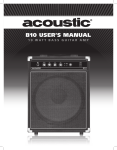
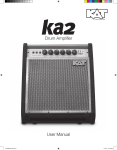
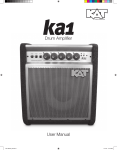
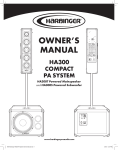
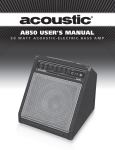
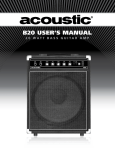
![View User`s Manual [US] - Acoustic Amplification](http://vs1.manualzilla.com/store/data/005929580_1-14523f44a960f194cc16791ff2ace09d-150x150.png)
